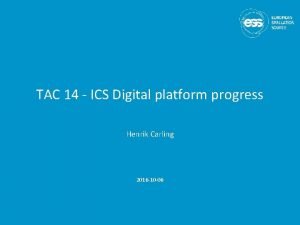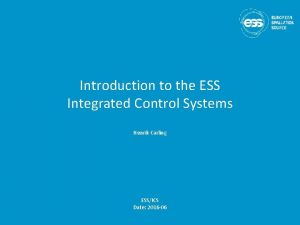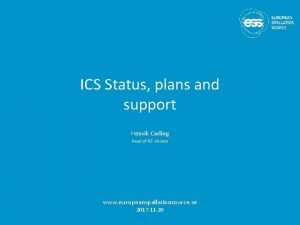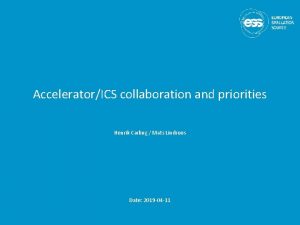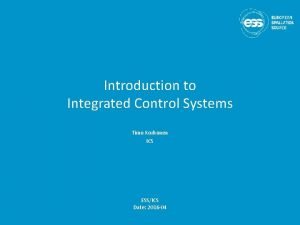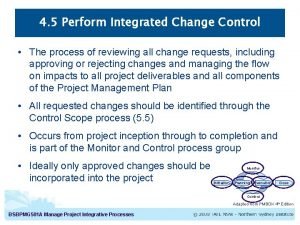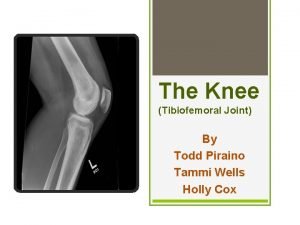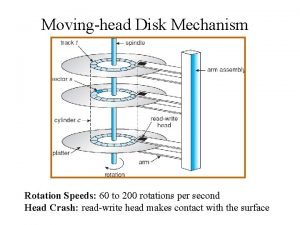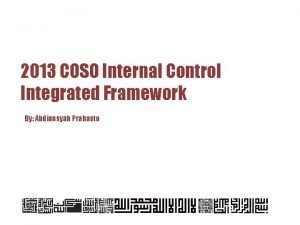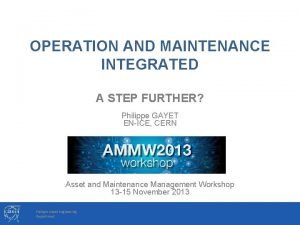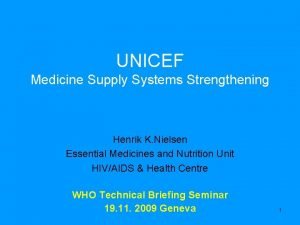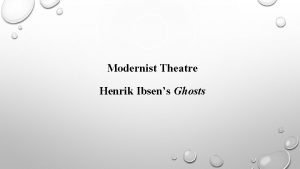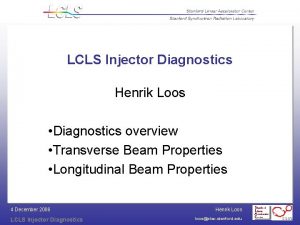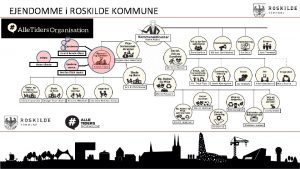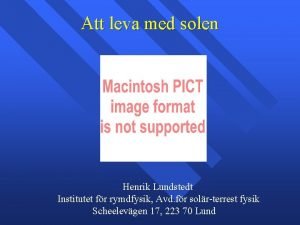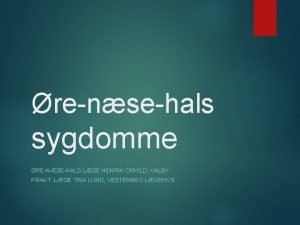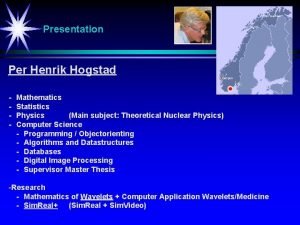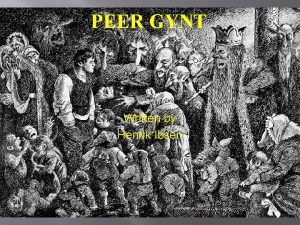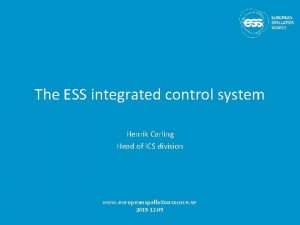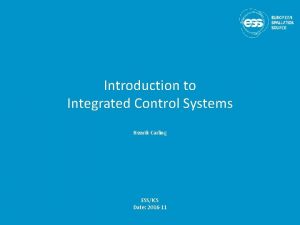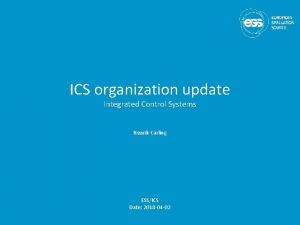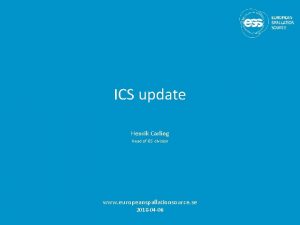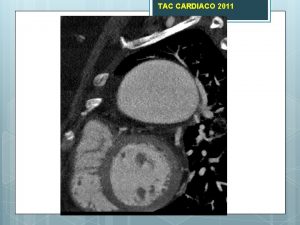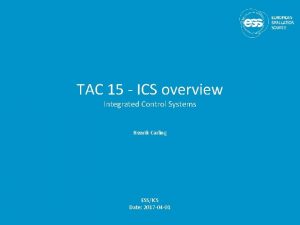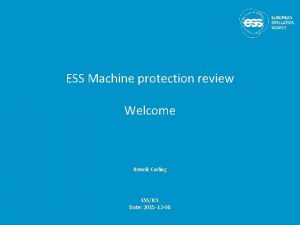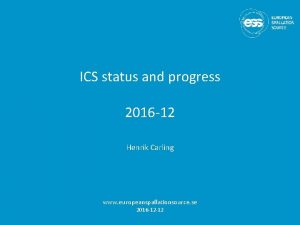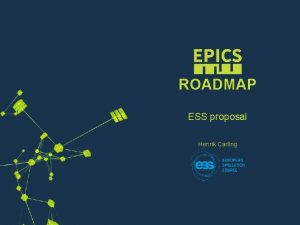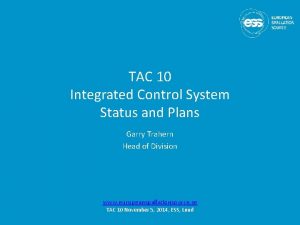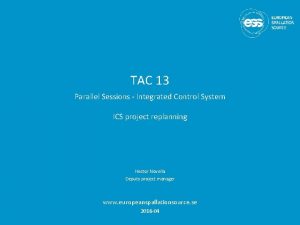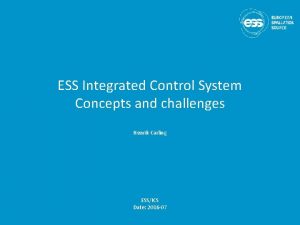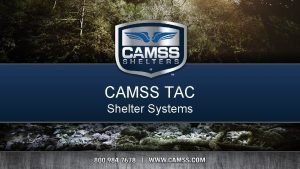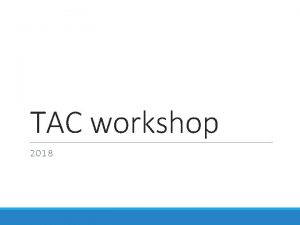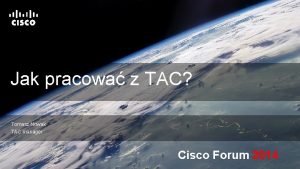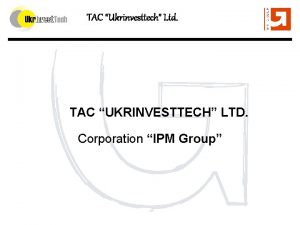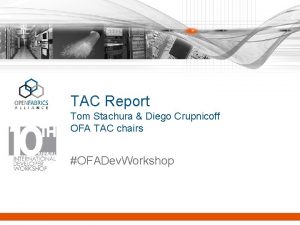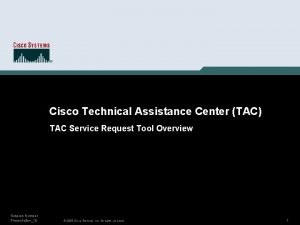TAC 13 Integrated control system Henrik Carling Head











![Status - Work packages [10. . 13] - Integration • Workpackage scope – • Status - Work packages [10. . 13] - Integration • Workpackage scope – •](https://slidetodoc.com/presentation_image_h2/494f252f94378e329dc005a5bdaa6541/image-12.jpg)






















- Slides: 34

TAC 13 Integrated control system Henrik Carling Head of ICS division www. europeanspallationsource. se 2016 -04

Introduction 2

High level accomplishments since last spring and since last review • There have been significant changes in ICS since the 2015 review More than 50% of the ICS management team is new A plan for structuring the governance of the division has been created The previous model for in-house/outsourced development has been revised The ICS project has been almost completely re-planned • This implies that estimates, risks and allocations will be re-made – The ICS in-kind portfolio has been almost completely changed – – • Accomplishments – – – New ICS management team in place and operational Operation context description created and is being implemented Vision, mission statements and communication structure created and implemented Roles and responsibilities within ICS clarified New project plan underway - several work packages now executing/transitioning to new plan In kind portfolio re-created, 10 - 15 % of ICS budget already identified and planned as in-kind 3

ICS Project scope Work package 01 Work package 02 Work package 03 Work package 04 Work package 05 Work package 06 Work package 07 Work package 08 Work package 09 Work package 10 Work package 11 Work package 12 Work package 13 Work package 14 Work package 20 Management and administration Software Applications Software core Hardware core Machine protection Equipment Control system infrastructure Physics Personnel safety systems Integration - Accelerator Integration - Target Integration - Instruments Integration - Conventional facilities Test Stands Installation 4

Work package status 5

Status - Work packages 2 and 3 - Software • Workpackage scope – Controls software development, integration and deployment in the ESS operations environment • Workpackage status – Many development activities have been started and have been ongoing for a long time (years) – ESS-wide requirements analysis and structured approach to identifying scope has been lacking – This means that the development efforts have gone on without central prioritization and review • Sometimes in the hands of commercial suppliers without strong enough ICS supervision – With a new line manager since Q 4 2015, this is changing • Issues – Lack of ESS-wide requirements analysis has led to arbitrary prioritization of ongoing efforts – Lack of ESS-wide requirements analysis has led to arbitrary budget allocation onto activities • Next steps – Systematic identification of “minimal scope” and hard prioritizations are ongoing – Packaging of control software products for in-kinding in order to balance budget spend A separate session on work packages 2 and 3 is scheduled tomorrow 6

Status - Work package 4 - Hardware core • – Micro. TCA digital platform (in-kind initiative) – Ether. CAT timing slave (in-kind initiative) – Timing system (commercial procurement) • Signal speed Workpackage scope 10 MHz 1 MHz Electronic front-end platform 10 k. Hz Work package status 1 k. Hz – Work is ongoing to set up the development of a standard electronics platform for high-end control applications as an in-kind contribution – Work is ongoing to set up the development of an Ether. CAT slave for interconnecting the timing and automation systems with good enough precision as an in-kind contribution – Work is ongoing with developing timing system IP as integrateable forware components • 100 k. Hz 100 Hz Ether. CAT 10 Hz Issues – In-kinding of hardware is a slow process - meanwhile, the window of central standardization of control electronics is closing • 1 Hz Next steps – Continue working on the in-kind processes Industrial automation (PLC) 0. 1 Hz 7

Status - Work package 5 - Machine protection • Work package Scope • • Work package Status – – • Machine Protection Committee with chairperson Annika Nordt effective First prototype of BIS ready First prototype of LPS for interceptive devices, magnet powering, bending magnets ready Ongoing work on systems requirements and systems architecture (all LPS and BIS) Issues – – – • Coordinate all activities required to deliver a coherent Machine Protection System (MPS) Deliver the following hardware systems – Beam Interlock System (BIS) – Local Protection Systems (LPS) for raster magnets, magnet powering, interceptive devices and more – Run Permit System, Be strongly involved in the implementation of the following software systems: – Software Interlock System – Post Mortem System – Configuration management of critical settings, code and systems Slow progress with the definition of protection functions for the target, Slow progress with the definition of interfaces for LPS’s Slow progress with definition of protection functions (such as LPS for interceptive devices) Little or no progress so far for the Post Mortem System, Run Permit System and Software Interlock System Too little communication with in kind partners: unaware of protection functions are being implemented Next Steps – – Prepare test in Catania (testing BIS and LPS for magnet powering and interceptive devices with beam) Finalise BIS architecture, analyse and freeze BIS requirements Build next BIS prototype Follow up all findings from MP review in December 2015 8

Status - Work package 7 - Infrastructure • Work package scope – Design and implementation of the ESS Main Control Room (MCR) – Control System Data Centre - servers and file storage infrastructure required for normal operation – Control System Network - design and implementation of the control networks • Work package status – MCR work is progressing well • Preliminary Design is %66 complete and on track • Using ISO 11064 Ergonomic Design of Control Centres standard. – Control System Data Centre work is on-going. • Requirements document is being developed • focus on system and storage performance. – Control System Network to schedule PDR in 2016 -06 • Communication rooms are well defined and cyber security requirements have been identified and documented according to IEC 62443 Industrial Network and System Security. – Good collaboration with Hardware & Integration, IT Operations & Support and Data Management and Software Centre (DMSC). • Issues – Control System Data Centre and Network: Standardisation needed between different IT stakeholders (DMSC, IT Operations & Support and ICS). • Next steps – Complete preliminary Design of Control Room and Control System Network. – Ensure intra-building/structured cabling conduits and cables trays from communications rooms to IO control zones are implemented. – Develop Data Centre system requirements further. 9

Status – Work Package 8 - Physics • Work package scope – Develop the control system software infrastructure for beam physics applications – Provide the control support for beam commissioning applications and machine model development – Address all the physics issues related to control (in collaboration with Accelerator Beam Physics) • Work package status – ESS Beam Physics application framework (with ESS/ICS developed physics model/simulator) tested successfully with SNS control system and with beam. 6 d phase space (envelope) matches well with experiment. IPAC papers are being written summarizing this work – Collaboration with Accelerator Beam Physics going very well. List of applications to be developed agreed – Integration of the application framework with Control System Services proceeding well. E. g. , RBAC (role based authentication ) integration is available for production testing • Issues (and Risks) – Plan requires external resources to deliver its milestones. • In-Kind resources are difficult to find (as it requires accelerator physics and software competencies) • The inability to hire consultants due to in-kind related cash illiquidity can lead to delay in schedule. • Next steps – Roll out first applications with Beam Physics section 10

Status - Work package 9 - Personnel Safety Systems • Work package Scope – Accelerator Personnel Safety System consisting of tunnel access control system, safety interlock system, radiation monitoring system and Oxygen Depletion Hazard (ODH) monitoring system, – Target PSS, consisting of the target access control system, the safety interlock system, the radiation monitoring system and the ODH monitoring system, – Personnel Safety system for the on-site cryomodule test stand, – A separate PSS for each Neutron Instrument • Work package Status – Good progress with accelerator PSS (design and relevant documentation to be finalised Q 4 2016), – Started work on the target PSS and PSS for the first 3 Neutron Instruments, – PSS test stand planned to be fully operational by June 2016 • Issues – There is a need to initiate an ESS-wide governance model for PSS (like the MPS committee) – More commitment from system stakeholders with an interface to PSS is needed – Budget for PSS is currently not entirely clear – The PSS schedule is very aggressive and more support is needed from ICS external stakeholders • Next Steps – Prepare review on accelerator PSS in July 2016 (with external reviewers) – Define requirements for the on-site cryo test stand, target, and Neutron Instruments PSS – Finalise accelerator PSS design – Finalise PSS test stand 11
![Status Work packages 10 13 Integration Workpackage scope Status - Work packages [10. . 13] - Integration • Workpackage scope – •](https://slidetodoc.com/presentation_image_h2/494f252f94378e329dc005a5bdaa6541/image-12.jpg)
Status - Work packages [10. . 13] - Integration • Workpackage scope – • Workpackage status – – • Control system integration of Accelerator, Target, Instruments and Conventional Facilities Team has been formed in the past 6 months and started interacting with stakeholders Activities for integrating Target and CF have been defined and added to the project plan Activities for integrating Instruments are being defined Definition of activities for integrating Accelerator has started - this is a big task Issues – Already, workload and competence/capacity gaps are appearing in the daily work • – • The team is creating workflows and methodologies for the administration of tasks, assigning priorities and workloads within the team to support the different activities in the different projects Many complex multi-party activities (ICS -> Accelerator -> In-kind partner -> Commercial supplier) Next steps – Increase team capacity through employment, secure commercial availability through framework agreements A separate session on work packages [10. . 13] is scheduled tomorrow 12

ICS organization and governance 13

ICS Organization - 2015 -05 Garry Trahern Anna Gillberg Annika Nordt Daniel Piso Fernández Miha Reščič Suzanne Gysin Ben Folsom Angel Montera Martinez Alexander Söderqvist Blaz Zupanc Remy Mudingay Denis Paulic Gregor Cijan Emanuele Laface Thilo Friedrich Manuel Zaera. Sanz Javier Cerejo Garcia Jaka Bobnar Henrik Carling Morteza Mansouri Sharifabad Klemen Strnisa Karin Rathsman Riccard Andersson Niklas Claesson Leandro Fernandez Stuart Birch Rok Stefanic Miha Novak Urša Rojec Miroslav Paleski Ziga Kroflic Richard Fearn Ivo List Employee Temporary employee Consultant off-site Blaz Kranjc NN Sunil, Sha NN Miha Vicorovic Sekoranja, Matej Ricardo Fernandes Timo Korhonen 14

ICS Organization - 2015 -07 Henrik Carling Anna Gillberg Annika Nordt Daniel Piso Fernández Miha Reščič Suzanne Gysin Ben Folsom Angel Monera Martinez Alexander Söderqvist Blaz Zupanc Remy Mudingay Denis Paulic Vacant Emanuele Laface Thilo Friedrich Manuel Zaera. Sanz Javier Cerejo Garcia Jaka Bobnar Morteza Mansouri Sharifabad Klemen Strnisa Karin Rathsman Riccard Andersson Niklas Claesson Leandro Fernandez Stuart Birch Francois Bellorini Miha Novak Urša Rojec Miroslav Paleski Nick Levchenko Richard Fearn Employee Temporary employee Consultant off-site Benedetto Gallese David Brodrick Technician (vacant) NN Sunil, Sha NN Miha Vicorovic Sekoranja, Matej Ricardo Fernandes Timo Korhonen 15

ICS Organization - 2015 -10 Henrik Carling Division head Anna Gillberg Team assistant ? IT/Infrastructure ? (Vacant? ) Annika Nordt Safety and protection Angel Monera Daniel Piso Hardware and integration Benedetto Gallese FPGA Engineer Integrator Denis Paulic David Brodrick PLC Engineer Manuel Zaera-Sanz PLC Engineer Morteza Mansouri Safety Engineer Riccard Andersson Ph. D student Stuart Birch Senior safety engineer Vacant IEC 61508 engineer Vacant Engineer? Integrator François Bellorini Integrator Javier Cerejo Integrator Jeong Han Lee Integrator Nick Levchenko Temporary employee Consultant off-site Ben Folsom Ph. D student ? Deputy chief engineer (Vacant) Karin Rathsman Senior scientist Leandro Fernandez Senior software engineer Vacant Software engineer Ricardo Fernandes Klemen Strnisa Thilo Friedrich Lead integrator Ph. D Student Niklas Claesson Matej Sekoranja Vacant Chief engineer Accelerator physicist Remy Mudingay Engineer? Timo Korhonen Emanuele Laface Alexander Söderqvist Integrator Position under consideration Control Software Senior software engineer Urša Rojec Consultant Susanne Regnell Integrator Employee Hector Novella Deputy project manager Infrastructure engineer Developer Consultants Vacant Engineer? 16

ICS Organization - 2016 -04 Henrik Carling Division head Anna Gillberg Team assistant ? IT/Infrastructure ? (Vacant? ) Annika Nordt Safety and protection Angel Monera David Brodrick Manuel Zaera-Sanz PLC Engineer Morteza Mansouri Safety Engineer Riccard Andersson Ph. D student Stuart Birch Senior safety engineer Yong Kian Sin IEC 61508 engineer Vacant Engineer? Temporary employee Consultant off-site Benedetto Gallese Denis Paulic Intern Integrator François Bellorini Integrator Javier Cerejo Ph. D Student Jeong Han Lee Integrator Nick Levchenko Integrator Vacant Software engineer Alexander Söderqvist Integrator Niklas Claesson Susanne Regnell Control Software Ben Folsom Ph. D student Timo Korhonen Chief engineer ? Deputy chief engineer (Vacant) Emanuele Laface Accelerator physicist Karin Rathsman Senior scientist Leandro Fernandez Senior software engineer Vacant Software engineer Ricardo Fernandes Senior software engineer Remy Mudingay Infrastructure engineer Thilo Friedrich Ph. D Student Consultants Integrator Vacant Engineer? Position under consideration Hector Novella Deputy project manager Integrator Julen Etxeberria Consultant Hardware and integration FPGA Engineer PLC Engineer Employee Daniel Piso Vacant Engineer? 17

ICS project plan 18

ICS work package re-planning status WP Title Work package manager Status 01 Administration Henrik Carling Done 02 Software Applications Leandro Fernandez Ongoing 03 Software Core Susanne Regnell Ongoing 04 Hardware core Timo Korhonen Ongoing 05 Machine protection system Annika Nordt Done 06 Equipment Timo Korhonen Not applicable Artefacts 75 In P 6 Comment Done * 260 Ongoing 07 Control system infrastructure Remy Mudingay Done 160 Ongoing 08 Physics Garry Trahern Done 150 Done 09 Personnel safety system Stuart Birch Done 250 10 Integration accelerator Han Lee Ongoing 11 Integration target Benedetto Gallese Done 12 Integration NSS David Brodrick Ongoing 13 Integration CF Nick Levchenko Done 14 Test stands Daniel Piso Pending 20 Installation Henrik Carling Pending * * * 275 Done 610 Done 19

High Level Schedule – Project ICS 2014 Global & Project MS 2015 2016 2017 2018 2019 First Installations 2020 2021 2022 2023 2024 2025 Handover Completed First Beam on Target Controls ready for #1 #2 #3 #4#5#6 integrated testing WP Integrations 1 st Bldg integration complete WP Personnel Safety Accelerator PSS-1 NMX controls ready for cold commissioning #1: Isrc+LEBT #2: +RFQ+MEBT #3: +DTL 1 #4: +DTL 2 -4 #5: +NCFE+. . . to DUMP #6: to TARGET Accelerator PSS-2 complete Target PSS complete WP Machine Protection Beam Interlock System installation started Beam Interlock System ready for High power beam commissioning WP SW, HW & Infrastructure Timing system components ready for procurement Temporary control room operational

ICS top risks Description of major cost and schedule risk exposure • • • ICS in-kind potential does not find a funding partner. Effort estimates are not accurate in ICS schedule. ICS internal processes are not mature enough. Stakeholders’ requirements change. ICS is working on assumptions for the design of the majority of the systems. Project wide concerns/mitigation measures • • • Strengthen communication to clarify the scope, specially on interfaces Continuously improve the schedule, increase planning integration with other Divisions Define the schedule in a way that facilitates in-kind activity creation and management Collaborate in quality assurance groups and commit to ESS recommended practices and tools Lower cost and increase competition for external services with new framework agreements 21

ICS in-kind status 22

ICS in-kind overview • Despite significant progress in planning and executing the revised strategy for ICS in -kind development, no new agreements have been closed since the last review • Development of three potential in-kind activities, two in Switzerland one in Estonia is at a point where signed agreements are expected within H 1 2016 • Since November last year this means that the ICS in-kind portfolio has grown from 5% goal coverage to 14% goal coverage • Further in-kind activities under discussion and development can the total ICS in-kind value to 10. 2 M€ which corresponds to 28% goal coverage • One of the difficulties of in-kinding control system activities is the low proportion of equipment value in the ICS portfolio • ICS is trying to further refine the process of discovering and creating in-kind opportunities 23

ICS n-kind activities • Despite that the a re-planning effort is on-going in ICS, we have managed to expand the in-kind agreed and potential values significantly over the past 6 months • With increased clarity in the software domain, we expect to be able to be more systematic in developing new in-kind opportunities 24

In-kind initiative with ZHAW

In-kind initiative with PSI 26

In-kind initiative with TUT 27

Response to previous TAC 28

Response to TAC 12 • • Comments The changes to the management and structure of the ICS Division are quite extensive. – – • Additional ICS IKCs may be possible as part of some of the large IKCs (cavities, modulators, cryoplant, …), by making them more turn-key. – – Ø • Such a refactor, at this stage of the project, is not without risk, but the previous structure and plans were at odds with experience in delivering comparable CS projects. The changes to the ICS Division are addressing these concerns However this will require ESS ICS effort to explore options; to establish whethere is interest and experience. To help enable such IKC, ICS Division should consider running training in EPICS and related development processes See answer to recommendation 1 There is no guarantee of delivering the aspired-to level of ICS IKCs. – Ultimately delivering a functional control system to the required programme is more important than achieving the IKC target 29

Response to TAC 12 • • Comments (continued) Communication between the ICS Division and the Accelerator Division team is very important. – Ø Ø Ø • Aspects of MPS functionality will be realized within the diagnostics hardware (FPGAs). – – – Ø Ø Ø • Consider high-level representation of ICS Division in the Accelerator Project management team meeting The ICS Deputy Project Manager is attending a weekly coordination meeting with Accelerator project managers Opportunities for improvement of communication between planners have been identified This is still an area where more improvement can be done - “working together” is increasingly more important Consideration should be given to how this will be managed during the life of ESS Consider how, when any given instrument is unavailable (faulty) this will be managed Consider minimizing hardware variants and management of the tool chain and development process Yes: The responsibility of the Machine Protection team is to provide guidelines for implementing protection functions in e. g. the diagnostics hardware (on FPGA level). A draft document describing the design process has been iterated with relevant stakeholders but needs to be released officially asap. Yes: Different masking features will be implemented on both sides: the Beam Interlock System and the Diagnostic systems (ongoing work) Yes: Variations of hw used for diagnostic systems will be minimised also by enforcing ICS hw standards There may be advantages in defining some diagnostic elements which are part of the MPS and so need more rigorous version management, than those used solely for measurement purposes Ø Yes and there is a lot of work in progress, eg. : definition of protection functions per diagnostics systems, enforcement to separate the protection functions from the diagnostics functions by either locking parts of an FPGA or using 2 separate 30 FPGAs), design reviews of the different systems with focus on their protection functions, thorough documentation, etc.

Response to TAC 12 • • Comments (continued) There is a good understanding on the control-system IT infrastructure requirements. – – – Ø • Possible solutions are well advanced and well aligned to the project’s needs. This will be a large and diverse work package with multiple logistical interfaces (i. e. CF, technical sub-systems, …) Consideration should be given to how to structure this work and the resources required to setup and manage this/these contracts The planning for the infrastructure work package is in good shape but staffing needs to be addressed In planning the temporary control room, consider how all the functionality, especially PSS, will be moved to the final control room. – Ø Once the facility is operational then there should only be one control room with write access to control parameters This is now the plan 31

Response to TAC 12 (from TAC 11) • • • Response to TAC 11 Good progress has been made with recommendations from TAC 11 There is on-going work in two areas Ø While the development environment has been defined, documenting hardware and software standards has not made progress. The ICS Division should take a pragmatic view and publish a light-weight set of documents which can be updated as the standards evolve The ICS Handbook has been created and will soon have it’s preliminary release – Ø Development of Interface Control Documents is ongoing and this is reasonable as subsystem requirements become available There are still opportunities for improvements with the ICDs – 32

Response to recommendations from TAC 12 • Recommendations – Ø Consider running training programmes in EPICS and related development processes for IKC partners and other possible controlsystem suppliers. This can be contracted out to a commercial organization; who will deliver training ranging from very generic EPICS training to a bespoke version for ESS’s development environment Through the new procurement framework agreement for software development services, ICS has specifically addressed the possibility of contracting professional EPICS training capacity. The framework agreement tender was subdivided into four “lots” or areas, of which two lots opened the possibility for offering EPICS training services. We are happy to see that many - if not all - of the top commercial players in the EPICS community have successfully responded to the tender. ICS has also created in-house training material for self-study purposes. Ø Revisit the goal for ICS IKC with ESS senior management, to produce a more realistic level. As part of which revisit the in-house staff level to compensate for any planned reduction in IKC In the period, the In-kind goal for ICS has been clarified and established to 50% of the 2013 ICS budget i. e. 36. 5 M€. – Ø Ø Ø All ESS IKC agreements should make a reference to compliance with ICS standards On ESS level, work is ongoing to refer to the ESS-wide standardization initiative [ESS-0042151] On ICS level, we refer to - in applicable cases - the Controls hardware standardization document [ESS-0037909] ICS will also soon refer to the “ICS handbook” which exists as a preliminary draft at the moment (estimated release Q 2 2016) – 33

34
 Henrik carling
Henrik carling Ess control system
Ess control system Henrik carling
Henrik carling Henrik carling
Henrik carling Ics integrated control systems
Ics integrated control systems Perform integrated change control
Perform integrated change control Dividing head chart
Dividing head chart The attacking firm goes head-to-head with its competitor.
The attacking firm goes head-to-head with its competitor. Operation of moving head disk storage
Operation of moving head disk storage Neck parts
Neck parts Pre-head head tonic syllable tail
Pre-head head tonic syllable tail Pro minent
Pro minent Quad innervation
Quad innervation What is tone unit
What is tone unit Moving head disk mechanism
Moving head disk mechanism Coso cube 2013
Coso cube 2013 Integrated control center
Integrated control center Henrik k
Henrik k Fogberedning
Fogberedning Ghosts as a modernist play
Ghosts as a modernist play Henrik loos
Henrik loos Henrik williams
Henrik williams Immunogram
Immunogram Henrik bendix olsen
Henrik bendix olsen Svensmark
Svensmark Henrik lundstedt
Henrik lundstedt Henrik svensmark
Henrik svensmark Henrik ibsen the wild duck
Henrik ibsen the wild duck Henrik
Henrik Katarralia
Katarralia What is the theme of a doll's house
What is the theme of a doll's house Per henrik hogstad
Per henrik hogstad Ibsen peer gynt summary
Ibsen peer gynt summary Why did the german soldiers come to uncle henrik’s house?
Why did the german soldiers come to uncle henrik’s house?
